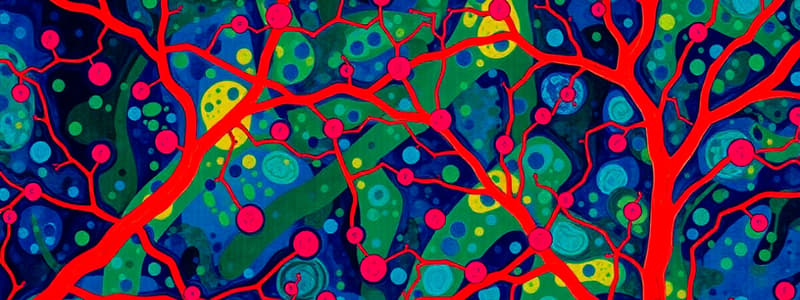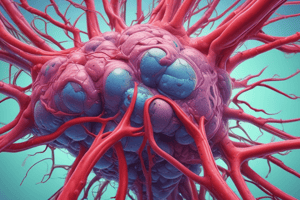Podcast
Questions and Answers
What is the main characteristic of continuous capillaries?
What is the main characteristic of continuous capillaries?
- They have large fenestrations for filtration.
- They are wider with many clefts.
- They consist of a tube of endothelial cells with intercellular clefts. (correct)
- They allow free passage of plasma proteins.
Which method of capillary exchange involves substances moving down their concentration gradient?
Which method of capillary exchange involves substances moving down their concentration gradient?
- Bulk flow
- Diffusion (correct)
- Active transport
- Transcytosis
What type of capillary is characterized by having large fenestrations?
What type of capillary is characterized by having large fenestrations?
- Continuous capillaries
- Arterioles
- Sinusoids
- Fenestrated capillaries (correct)
What allows transcytosis to occur in capillaries?
What allows transcytosis to occur in capillaries?
Which method of capillary exchange allows large, lipid-insoluble molecules to cross the endothelium?
Which method of capillary exchange allows large, lipid-insoluble molecules to cross the endothelium?
What type of capillary allows smaller plasma proteins to pass but restricts most from crossing?
What type of capillary allows smaller plasma proteins to pass but restricts most from crossing?
What is the main purpose of bulk flow in the body?
What is the main purpose of bulk flow in the body?
What pressure is primarily responsible for promoting reabsorption at the venous end of a capillary?
What pressure is primarily responsible for promoting reabsorption at the venous end of a capillary?
At the arterial end of a capillary, what is the net filtration pressure (NFP)?
At the arterial end of a capillary, what is the net filtration pressure (NFP)?
Which pressure is close to zero and affects filtration and reabsorption in capillaries?
Which pressure is close to zero and affects filtration and reabsorption in capillaries?
Which factor contributes minimally to interstitial fluid osmotic pressure (IFOP)?
Which factor contributes minimally to interstitial fluid osmotic pressure (IFOP)?
What defines the net filtration pressure (NFP) formula?
What defines the net filtration pressure (NFP) formula?
What is the typical range of blood hydrostatic pressure (BHP) across a capillary bed?
What is the typical range of blood hydrostatic pressure (BHP) across a capillary bed?
What is the significance of blood colloid osmotic pressure (BCOP)?
What is the significance of blood colloid osmotic pressure (BCOP)?
What happens to thoracic pressure during inhalation?
What happens to thoracic pressure during inhalation?
What is the formula for calculating cardiac output (CO)?
What is the formula for calculating cardiac output (CO)?
Which factor does NOT affect blood pressure?
Which factor does NOT affect blood pressure?
What is the minimum mean arterial pressure (MAP) required to adequately perfuse vital organs?
What is the minimum mean arterial pressure (MAP) required to adequately perfuse vital organs?
Which of the following factors contributes to vascular resistance?
Which of the following factors contributes to vascular resistance?
Where is the velocity of blood flow slowest?
Where is the velocity of blood flow slowest?
What is the primary reason for the presence of venous valves?
What is the primary reason for the presence of venous valves?
What percentage of fluid filtered through tissues is typically reabsorbed?
What percentage of fluid filtered through tissues is typically reabsorbed?
What characteristic of venules allows for the exchange of elements?
What characteristic of venules allows for the exchange of elements?
Which statement best describes the structural adaptations of veins?
Which statement best describes the structural adaptations of veins?
What condition is most likely to result when filtration exceeds reabsorption?
What condition is most likely to result when filtration exceeds reabsorption?
Which type of vein is more numerous and located within the subcutaneous layer?
Which type of vein is more numerous and located within the subcutaneous layer?
What is the primary role of the lymphatic system in relation to fluid balance?
What is the primary role of the lymphatic system in relation to fluid balance?
What structural feature of veins contributes to their function as blood reservoirs?
What structural feature of veins contributes to their function as blood reservoirs?
What volume of blood can veins accommodate, representing their capacity as blood reservoirs?
What volume of blood can veins accommodate, representing their capacity as blood reservoirs?
As venules move away from capillaries, what structural change occurs?
As venules move away from capillaries, what structural change occurs?
Study Notes
### Capillaries
- Smallest blood vessels
- Diameter between 5–10µm
- U-shaped vessels connect arterial and venous blood flow
- Thin walls with no tunica media or externa
- Extensive network of branched vessels throughout the body ### Microcirculation
- Blood flow through metarterioles, capillaries, and venules
- Single metarteriole supplies a capillary bed
- Thoroughfare channel: route from arteriole to venule ### Types of Capillaries
- Continuous Capillaries: Tube of endothelial cells with intercellular clefts
- Fenestrated Capillaries: Contain pores known as fenestrations
- Sinusoids: Wider capillaries with large fenestrations and clefts ### Capillary Exchange
- Movement of substances between blood and interstitial fluid
- Diffusion: Most important exchange method, substances move down their concentration gradient. Water-soluble substances move through intercellular clefts or fenestrations. Lipid-soluble substances move through endothelial cells.
- Transcytosis: Small amount of material from blood plasma become enclosed in vesicles and transported across the cell. Mainly large, lipid-insoluble molecules.
- Bulk Flow: Based on pressure gradients, promotes movements of large volumes of fluid. Important for regulating blood and interstitial fluid volumes.
- Filtration: Movement from capillaries into interstitial fluid.
- Reabsorption: Movement from interstitial fluid into capillaries. ### Pressures Regulating Filtration and Reabsorption
- Blood Hydrostatic Pressure (BHP): Pressure of water in the plasma against vessel walls; ranges from 35 to 16 mmHg.
- Interstitial Fluid Hydrostatic Pressure (IFHP): Close to 0 mmHg.
- Interstitial Fluid Osmotic Pressure (IFOP): 0.1-5mmHg, small amount of proteins in interstitial fluid.
- Blood Colloid Osmotic Pressure (BCOP): Due to the presence of plasma proteins which are too big to cross the capillary walls. Averages 26 mmHg. ### Net Filtration Pressure (NFP)
- The balance of pressures promoting filtration and reabsorption.
- Calculated using the formula: (BHP + IFOP) – (BCOP + IFHP).
- Arterial End of Capillary: NFP = 10 mmHg, promoting filtration.
- Venous End of Capillary: NFP = -9mmHg, promoting reabsorption. ### Starling’s Law
- Nearly as much fluid is reabsorbed as filtered.
- About 85% of filtered fluid is reabsorbed.
- 20 liters of fluid are filtered daily, 17 liters are reabsorbed, 3 liters enter the lymphatic system and return to the blood. ### Edema
- Filtration exceeds reabsorption.
- Increase in interstitial fluid volume. ### Venules
- Thin walls that collect capillary blood.
- Postcapillary venules: (10–50 µm) porous and allow for exchange.
- As venules become thicker with more smooth muscle (50–200 µm), exchange becomes less likely.
- Very elastic walls make them a good reservoir for blood. ### Veins
- Diameter from 0.5 mm to 3 cm.
- Thinner walls than arteries, larger lumen, less muscle.
- Thick tunica externa with collagen, elastic fibers, and lack of internal and external elastic laminae.
- Larger lumen, can distend well but cannot withstand high pressure.
- Superficial veins: Subcutaneous layer.
- Deep veins: Between skeletal muscles.
- Anastomotic veins: Connections between veins, allows blood from capillaries to flow to the heart even if the primary vein is obstructed. ### Veins and Valves
- Can accommodate large volumes of blood.
- Hold up to 65% of blood volume.
- Low blood pressure due to larger lumen.
- Adaptations to ensure blood returns to the heart:
- Large lumen: Low resistance
- Venus valves: Prevents backflow. Formed from tunica intima, resembles semi-lunar valves of the heart. ### Respiratory Pump
- Pressure changes in the thoracic and abdominal cavities aid blood return.
- Inhalation: Diaphragm moves down, decreasing thoracic pressure and increasing abdominal pressure.
- Blood flows from abdominal veins to thoracic veins.
- Exhalation: Valves prevent backflow. ### Hemodynamics: Blood Flow
- Volume of blood through a given tissue in a given time period, measured in mL/min.
- Total blood flow is equivalent to cardiac output (CO).
- CO = heart rate (HR) x stroke volume (SV)
- Distribution of CO depends on:
- Pressure difference, blood flows from high to low pressure areas.
- Resistance, opposition to blood flow. ### Blood Pressure
- Generated by contraction of the ventricles.
- Pressure decreases progressively with distance from the left ventricle.
- Systolic BP: Highest pressure during systole, ventrical contraction
- Diastolic BP: Lowest arterial pressure, relaxation of ventricles. ### Mean Arterial Pressure (MAP)
- Average blood pressure in arteries.
- Calculated as: MAP = SBP + 2 (DBP) / 3.
- Must be above 60 mmHg to perfuse vital organs.
- Depends on:
- Total volume of blood.
- Cardiac output
- Vascular resistance. ### Vascular Resistance
- Opposition to blood flow due to friction between blood and vessel walls.
- Depends on:
- Size of Lumen: Smaller lumen, greater the resistance.
- Blood Viscosity: Thicker the blood, greater the resistance.
- Total Blood Vessel Length: Longer the length, greater the resistance. ### Velocity of Blood Flow
- Speed of blood flow is inversely related to cross-sectional area, slower where the area is greatest.
- Slowest in capillaries
- Faster in venules when they unite
- The total circulation time is 1 minute. ### Chemoreceptors
- Monitor chemical composition of blood.
- Located near baroreceptors in carotid sinuses and aortic arch.
- Detect:
- Hypoxia: Low oxygen levels
- Acidosis: High acidity
- Hypercapnia: High carbon dioxide levels.
- Transmit impulses to the cardiovascular center (CVC).
- Stimulate sympathetic nervous system to cause vasoconstriction. ### Hormonal Regulation of BP
- Renin-Angiotensin-Aldosterone (RAA) System:
- Reduced blood flow to kidneys: Stimulates renin release.
- Renin and ACE enzyme stimulate angiotensin II: Vasoconstrictor and increases aldosterone secretion.
- Aldosterone: Increases Na+ and water reabsorption, increasing blood volume.
- Epinephrine and Norepinephrine:
- Adrenaline hormones released by the adrenal medulla.
- Increase HR and force of contraction, leading to higher CO.
- Vasoconstrict arterioles.
- Antidiuretic Hormone (ADH):
- Produced by hypothalamus in response to low blood volume.
- Causes vasoconstriction.
- Promotes water movement from kidney tubules to bloodstream.
- Atrial Natriuretic Peptide (ANP):
- Released by atria of heart in response to high blood volume.
- Promotes vasodilation and loss of salt and water.
- Reduces CO.
### Autoregulation of BP
- Tissue's ability to automatically adjust blood flow.
- Causes vasodilation and vasoconstriction.
- Important for distributing blood to active areas.
- Types of changes in blood flow:
- Physical changes: Warming (vasodilate), cooling (constrict), and myogenic response (smooth muscle reacts to changes in blood flow).
- Chemicals: Cells release chemicals for vasodilation or vasoconstriction.
Studying That Suits You
Use AI to generate personalized quizzes and flashcards to suit your learning preferences.
Related Documents
Description
Test your knowledge on capillaries and microcirculation, including the types of capillaries and their roles in blood flow and exchange. This quiz covers the structure, function, and significance of these smallest blood vessels within the circulatory system.




